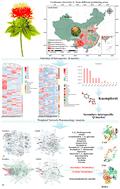当前位置:
X-MOL 学术
›
Food Funct.
›
论文详情
Our official English website, www.x-mol.net, welcomes your
feedback! (Note: you will need to create a separate account there.)
Identification of a secondary Q-marker in high-quality ecotypes of Carthamus tinctorius L. and exploration of the target preference
Food & Function ( IF 5.1 ) Pub Date : 2023-02-15 , DOI: 10.1039/d2fo02596e Tiexin Zeng 1, 2 , Qi Xiao 1 , Jianuo Zhang 1 , Xiao Sun 1 , Baolin Guo 1 , Jin Pei 2 , Lin-Fang Huang 1
Food & Function ( IF 5.1 ) Pub Date : 2023-02-15 , DOI: 10.1039/d2fo02596e Tiexin Zeng 1, 2 , Qi Xiao 1 , Jianuo Zhang 1 , Xiao Sun 1 , Baolin Guo 1 , Jin Pei 2 , Lin-Fang Huang 1
Affiliation

|
Safflower (Carthamus tinctorius) has the efficacy for promoting blood circulation and preventing cardiovascular and Alzheimer's diseases and is thus a valuable medicinal and functional food plant. However, how to evaluate high-quality safflower is still a problem. To differentiate intraspecies ecotypes and illustrate the mechanisms of differential metabolites of C. tinctorius from different regions, this study combined the widely targeted metabolome, weighted network pharmacology, and molecular docking to filter bioactive compounds and predict the target preference. The results indicated that kaempferol is suitable as a secondary Q-marker to differentiate intraspecies ecotypes. In secondary metabolites, the average content of kaempferol and its derivates in C. tinctorius from Sichuan is three times that of other areas, which have the potential for the targeted medicine of CA2 and TNF. In volatile metabolites, isoaromadendrene epoxide has the potential as a specifically targeted medicine of RXRA. The change of the target preference could be the reason for the difference in drug efficacy among different varieties of C. tinctorius. It is reasonable that Sichuan was recognized as a high-quality ecotype producing region of C. tinctorius in China, which promotes blood circulation and removes blood stasis. This study provides an innovative method to differentiate intraspecies ecotypes and explore their target preference.
更新日期:2023-02-15















































 京公网安备 11010802027423号
京公网安备 11010802027423号